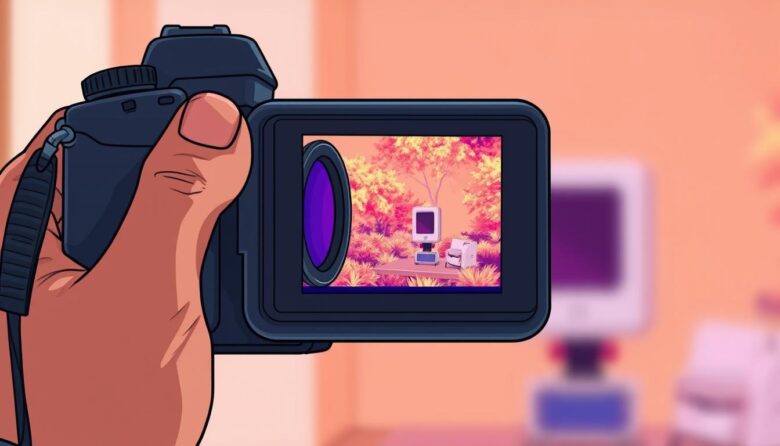Your smartphone or digital camera holds a hidden capability most users never discover. Modern imaging systems can reveal wavelengths beyond what human eyes perceive, unlocking a world of unseen activity.
While our vision stops at red hues, standard camera sensors detect near-infrared emissions. This creates visible white or blue flashes on screens when capturing remote controls, security systems, or other IR sources.
These tools aren’t limited to tech professionals. Homeowners use them to check TV remotes. Scientists analyze plant health through thermal patterns. Even DIY enthusiasts troubleshoot electronics using this built-in feature.
Our guide explores how everyday devices achieve this feat. You’ll learn why silicon sensors naturally respond to infrared, how to optimize settings for clearer results, and which apps enhance this functionality. We’ll also cover safety measures to protect both eyes and equipment.
From basic theory to advanced techniques, you’ll gain practical skills for turning common gadgets into powerful diagnostic tools. Let’s illuminate the invisible.
Understanding Infrared Light: Basics and Applications
The electromagnetic spectrum contains more than meets the human eye. Beyond the colors we perceive lies a realm of energy waves that transfer heat and data. These emissions sit just below red in the visible light range, bridging the gap between sight and thermal sensation.
What Is Infrared Light?
This energy form operates between 430 THz and 300 GHz frequencies. Materials react uniquely to these wavelengths – warmer objects emit stronger signals, while cooler surfaces reflect them differently. Our biological vision systems lack receptors for these emissions, but modern sensors convert them into visual data.
Everyday Applications and Benefits
Thermal imaging systems transform hidden energy patterns into color-coded maps for building inspections and medical diagnostics. Security teams identify concealed electronics through their heat signatures. Even common devices like TV remotes use this technology for wireless communication.
Environmental scientists track plant health by analyzing thermal emissions, while homeowners monitor insulation efficiency. These practical uses demonstrate how invisible energy shapes our visible world through specialized imaging solutions.
How Infrared Detection Works on Digital Cameras
Modern imaging devices contain a surprising technical feature in their optical systems. Most digital cameras and smartphones use sensors that capture light beyond the visible spectrum, though this capability remains hidden in standard operation.
Camera Sensor Sensitivity to Specific Wavelengths
CMOS and CCD detectors naturally respond to energy across multiple spectra. Each pixel contains photodiodes that convert both visible and non-visible wavelengths into electrical signals. This dual sensitivity allows sensors to record data most humans can’t perceive.
Manufacturers optimize pixel architecture for color accuracy in normal photography. However, variations in photodiode responses create differences in resolution across light frequencies. Higher-end cameras often achieve better performance through specialized sensor designs.
Managing Unwanted Light Signals
Consumer devices incorporate physical filters to block unwanted wavelengths. These thin glass layers sit between the lens and sensor, absorbing specific energy ranges. By eliminating interference, they ensure accurate color reproduction in daylight conditions.
Removing these components enhances non-visible light capture but alters standard functionality. Modified cameras gain enhanced capabilities at the cost of distorted colors in regular photos. Professional thermal imaging systems avoid this trade-off through dedicated sensor arrays optimized for heat signature analysis.
infrared detection with phone: Exploring the Technology
Modern mobile devices pack more imaging power than most users realize. Built-in CMOS sensors capture light beyond our visual spectrum, creating opportunities for creative experimentation. While not designed for professional thermal analysis, these tools offer accessible ways to interact with hidden energy patterns.
Smartphone Imaging Capabilities
Android and iOS handle non-visible light differently. Apple applies specialized filters to rear cameras, forcing apps to use front sensors for analysis. This design choice preserves color accuracy but limits functionality. Android models typically allow both cameras to record broader wavelength ranges.
Advanced photography features enhance results. Manual exposure settings help isolate faint signals. Digital zoom focuses on specific areas, while real-time previews let users adjust framing instantly. Third-party applications leverage processing power to refine captured data through contrast adjustments and noise reduction.
The compact nature of mobile phones makes them ideal for fieldwork. Unlike bulky thermal cameras, these devices fit in pockets while providing immediate feedback. Pairing them with clip-on filters or external light sources expands their utility for specialized tasks.
Accessory compatibility opens new possibilities. Attachable lenses improve detail capture, and LED arrays boost signal strength. These enhancements transform everyday gadgets into versatile diagnostic tools without requiring technical expertise.
Step-by-Step How-To for Detecting Infrared Light
Unlocking your device’s hidden potential starts with proper setup. Follow these methods to transform everyday tools into diagnostic equipment, revealing energy patterns hidden from biological vision.
Preparing Your Device and Environment
Begin by opening your camera app or specialized scanning software. Disable automatic flash and reduce exposure settings to minimize glare. Manual focus modes often provide clearer results than autofocus for this purpose.
Create optimal conditions by dimming ambient lighting. Close curtains and turn off lamps to eliminate competing light sources. Remove reflective objects like mirrors or metallic surfaces that could distort readings.
Scanning Your Surroundings for Emissions
Hold your device steady at chest height. Slowly rotate 360 degrees while monitoring the screen. Watch for sudden bright spots that appear without visible cause – these signals escape normal vision but register on sensors.
Test your setup using a TV remote. Aim its transmitter at the lens and press buttons. A flashing dot confirms proper functionality. This verification step ensures your equipment works before critical inspections.
For thorough coverage, divide large spaces into grid sections. Methodically examine each zone, maintaining consistent distance from walls. Pay special attention to vents, smoke detectors, and decorative items that might conceal equipment.
Utilizing Apps and Tools for Enhanced IR Detection
Mobile applications transform standard devices into precision analysis tools. Specialized software amplifies sensor capabilities, turning casual users into skilled observers of hidden energy patterns.
Top Applications for Clearer Results
Leading camera detector apps combine multiple scanning methods. Advanced algorithms process signals from sensors while filtering ambient interference. iOS options automatically activate front-facing lenses, bypassing Apple’s restrictive rear-camera filters.
Premium versions offer adjustable contrast sliders and manual zoom controls. These features isolate faint emissions in cluttered environments. Free apps provide basic functionality but lack real-time processing upgrades available in paid packages.
Maximizing Visual Clarity
Adjust filters to suppress glare from artificial lighting. High-contrast modes highlight subtle differences in emission intensity. For Android users, third-party tools unlock sensor potential through customizable exposure settings.
Update apps regularly to access improved quality in signal interpretation. Developers frequently refine noise reduction techniques and detection algorithms. This ensures compatibility with evolving hardware standards across device models.
Practical Testing and Performance Insights
Validating your equipment’s capabilities requires structured evaluation methods. Controlled experiments separate genuine signals from environmental noise, revealing true operational limits. This process transforms casual observations into reliable data through repeatable verification steps.
Bench Testing Techniques and Real-World Examples
Lab-grade analysis begins with standardized light sources and calibrated measurements. Spectral sensitivity tests map sensor responses across wavelengths using monochromatic emitters. Signal linearity checks confirm consistent output at varying intensity levels – critical for accurate thermal pattern recognition.
Field applications demonstrate practical value. Technicians identify faulty wiring through abnormal heat signatures in walls. Energy auditors pinpoint insulation gaps by analyzing temperature differentials. Each scenario demands specific techniques for optimal results.
Comparative studies reveal hardware differences. Flagship smartphones often outperform budget models in spatial resolution testing, capturing finer details. However, mid-range devices may excel in low-light conditions due to aggressive noise reduction algorithms.
Documentation protocols ensure reliable performance tracking. Time-stamped records with environmental conditions help isolate variables during analysis. This approach minimizes false conclusions from temporary interference or calibration drift.
Common challenges include ambient heat sources and reflective surfaces. Strategic positioning and timed measurements mitigate these issues. Regular sensor cleaning and software updates maintain consistent results across diverse operating environments.
Comparing Mobile IR Detection to Professional Imaging Systems
Imaging technology has evolved dramatically, blurring the lines between consumer gadgets and professional tools. Modern sensors in both scientific equipment and everyday devices now share surprising capabilities. This comparison reveals where each system excels – and where compromises occur.
CCD Versus Smartphone Sensor Performance
Scientific-grade CCD cameras maintain sensitivity across extreme light conditions. Their specialized sensors deliver consistent results through precise signal linearity. Consumer devices match initial sensitivity levels but falter when signals weaken or intensify.
Smartphone cameras show remarkable adaptability despite technical constraints. Green pixels in mobile sensors achieve near-CCD linearity for accurate pattern recognition. Red and blue elements handle weaker signals effectively, though with reduced clarity in complex scenarios.
Resolution differences prove most noticeable. Professional systems capture fine details through dense sensor arrays. Mobile devices compensate with computational processing, enhancing apparent sharpness despite lower physical pixel counts.
Cost remains a decisive factor. High-end imaging systems require significant investment, while smartphone solutions offer portable functionality at marginal expense. For routine inspections and basic analysis, mobile tools often provide sufficient imaging capability without specialized equipment.
Innovative Uses of Infrared and Thermal Imaging in Daily Life
Modern thermal technology transforms routine tasks into proactive safety measures. Once limited to industrial settings, these tools now empower homeowners and hobbyists to identify hidden risks. From electrical maintenance to nocturnal security, everyday applications reveal energy patterns that shape our environments.
Home Diagnostics and Electrical Component Checks
Spotting overheating components prevents dangerous failures before sparks fly. Thermal scans expose frayed wires in walls and overloaded circuits behind panels. A quick sweep across outlets reveals abnormal heat buildup – a silent warning of potential fire hazards.
HVAC inspections become precise with thermal analysis. Locate air leaks around windows or track radiator efficiency through color-coded heat maps. Mechanics use this approach to diagnose car engines, identifying stuck brakes or cooling system flaws through temperature variations.
Applications in Night Vision and Thermal Imaging
After sunset, thermal devices become indispensable safety tools. A quality night vision camera illuminates pathways without visible light, detecting obstacles 100 meters ahead. Security teams monitor properties in total darkness, spotting intruders through body heat signatures.
Advanced attachments like MobIR 2S measure surface temperatures within ±2℃ accuracy. This precision helps evaluate insulation performance or troubleshoot electronics. Whether navigating unlit trails or inspecting roof leaks, thermal capabilities turn darkness into actionable data.
Final Reflections on Mobile Infrared Detection for Modern Users
Portable imaging breakthroughs are reshaping how we interact with our surroundings. Everyday smartphones now rival specialized equipment through advanced pixel arrays and adaptive lens systems. These tools democratize scientific capabilities, turning casual users into informed observers of hidden phenomena.
Emerging trends focus on refining image quality through computational photography. Enhanced color mapping transforms raw sensor data into actionable insights. Attachable filters expand functionality without compromising device portability.
Medical applications show particular promise. Researchers prototype systems for early disease screening using smartphone cameras. Environmental teams track animal migrations through thermal patterns captured in remote areas. Such innovations highlight the technology’s societal impact.
Future developments will prioritize measurement precision through stacked pixel designs and AI-powered processing. These upgrades will make professional-grade analysis accessible for personal and community purpose. As hardware evolves, so will our ability to decode the invisible world through pocket-sized devices.



